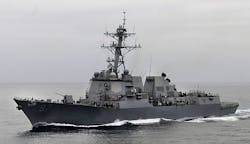Navy asks Boeing to continue support for GEDMS Gigabit Ethernet shipboard networking
Officials of the Naval Surface Warfare Center Dahlgren Division in Dahlgren, Va., are asking the Boeing Defense, Space & Security segment in Huntington Beach, Calif., to continue support of the shipboard AN/USQ-82(V) Gigabit Ethernet Data Multiplex Systems (GEDMS) program.
The GEDMS network transfers inputs and outputs for the Burke-class destroyer's machinery control systems, damage control system, steering control system, Aegis combat system, navigation displays, and interior communications alarms and indicators.
Boeing designed the shipboard network to replace the mile of point-to-point cabling, signal converters, junction boxes, and switchboards that make up a conventional ship’s cabling, Navy officials say.
GEDMS will be installed on new Burke-class destroyers, as well as part of upgrades to back-fitted to 27 flight I/II Burke-class destroyers hull numbers 51 to 78, and to 28 flight IIA Burke-class destroyers hull numbers 79 to 107.
The GEDMS is designed to transfer data via a reliable, redundant, mission-critical network backbone aboard Navy surface warships. It is the most recent upgrade to the Navy's Data Multiplex System (DMS) networks, and offers enhanced network communication capabilities by providing an IP-based backbone that supports multimedia services such as video and data.
GEDMS increases a surface ship's capacity to support data transfer for the Burke-class destroyer's latest upgraded hull, mechanical, and electrical systems. Additional benefits include manpower reduction and increased crew safety by using video and sensors for monitoring of remote or confined spaces, Boeing officials say.
In September 1989, Boeing delivered the first DMS system to the Navy for installation aboard the USS Arleigh Burke, the namesake for the DDG 51 class destroyer. As the DDG new ship construction continued, the DMS was upgraded to a Fiber Optic Data Multiplex System (FODMS) to support evolving needs.
Related: Boeing to provide fiber-optic high-speed shipboard networking for three new Navy destroyers
In August 2010, the Navy replaced the copper-based DMS systems installed on the Arleigh Burke and the USS John Paul Jones (DDG 53) with the high-performance fiber-optic GEDMS, the latest variant in the DMS family of networks.
The manufacturer of the GEDMS fiber-optic shipboard network is Argon ST, a wholly owned subsidiary of Boeing. Boeing acquired Argon ST in 2010 as part of the company's strategy to expand its capabilities to address the C4ISR, cyber security, and intelligence applications. Argon ST is a division of Boeing Network & Space Systems, a business of the Boeing Defense, Space & Security operating unit.
This contract modification, announced on 22 March, combines purchases for the Navy, as well as for and the governments of Australia, Korea, and Japan. Boeing will do the work in Huntington Beach, Calif; Arlington, Va; Bath, Maine; Pascagoula, Miss.; Washington, D.C.; Richardson, Texas; and Fairfax, Va., and should be finished by March 2017.
For more information contact For more information contact Boeing Defense, Space & Security online at www.boeing.com/company/about-bds, Argon ST at www.argonst.com, or the Naval Surface Warfare Center Dahlgren Division at www.navsea.navy.mil/Home/WarfareCenters/NSWCDahlgren.
